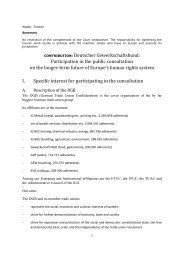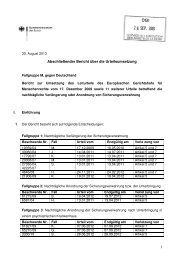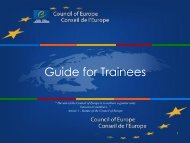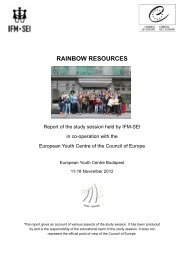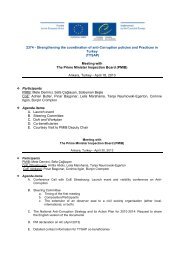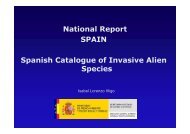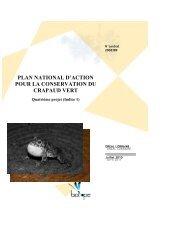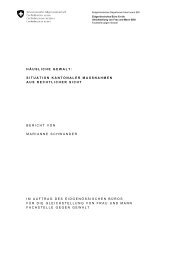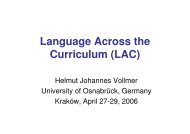Money laundering through money remittance ... - Council of Europe
Money laundering through money remittance ... - Council of Europe
Money laundering through money remittance ... - Council of Europe
Create successful ePaper yourself
Turn your PDF publications into a flip-book with our unique Google optimized e-Paper software.
<strong>Money</strong> Laundering <strong>through</strong> <strong>Money</strong> Remittance and Currency Exchange Providers - 2010 <br />
EXECUTIVE SUMMARY<br />
1. This joint FATF/MONEYVAL report contains information on <strong>money</strong> <strong>laundering</strong> and<br />
terrorist financing methodologies associated with the <strong>money</strong> <strong>remittance</strong> and currency exchange sector.<br />
The findings contained in the report derive from information provided by 61 FATF, MONEYVAL and<br />
Egmont Group member States and other open source material. Though the focus <strong>of</strong> the report is to a<br />
certain degree on the MONEYVAL region and the wider <strong>Europe</strong>an area, the experience <strong>of</strong> countries<br />
from other regions <strong>of</strong> the world was actively sought and integrated into the report.<br />
2. Apart from providing a useful general overview <strong>of</strong> the sector <strong>of</strong> <strong>money</strong> transfer <strong>remittance</strong>s<br />
and currency exchange providers, the regulatory framework, the supervision and sanctioning regimes,<br />
the report sets out identified <strong>money</strong> <strong>laundering</strong> and terrorist financing methods and techniques<br />
involving <strong>money</strong> <strong>remittance</strong> and currency exchange providers.<br />
3. Several case studies described in this report illustrate that <strong>money</strong> <strong>remittance</strong> and currency<br />
exchange businesses have been both witting and unwitting participants in <strong>laundering</strong> activities, in all<br />
three stages <strong>of</strong> the process (placement, layering and integration), and in certain instances, for terrorist<br />
financing purposes. The identified risks <strong>of</strong> ML/TF <strong>through</strong> the sector detailed in the report are related<br />
to clients, owners or agents. The cases highlight also the links between <strong>money</strong> <strong>laundering</strong> in the<br />
<strong>money</strong> <strong>remittance</strong> sector and other criminal activities (e.g., fraud, trafficking in human beings,<br />
smuggling, drug trafficking, economic crime).<br />
4. A number <strong>of</strong> vulnerabilities to <strong>money</strong> <strong>laundering</strong> across the sector that make up the <strong>money</strong><br />
<strong>remittance</strong> and currency exchange sector were identified. The analysis <strong>of</strong> the case studies and other<br />
materials enabled the project team to compile numerous examples <strong>of</strong> indicators <strong>of</strong> potential <strong>money</strong><br />
<strong>laundering</strong> activities related to transactions, customer pr<strong>of</strong>ile and behaviour as well as specific<br />
indicators for bureaux de change and <strong>money</strong> <strong>remittance</strong> providers that may help the industry to<br />
identify and describe suspicious behaviours and protect themselves against <strong>money</strong> launderers and<br />
other criminals.<br />
5. Clearly, <strong>laundering</strong> <strong>through</strong> <strong>money</strong> <strong>remittance</strong> and currency exchange providers poses a<br />
number <strong>of</strong> regulatory and enforcement challenges. At the same time, it was observed that there is low<br />
detection <strong>of</strong> <strong>money</strong> <strong>laundering</strong> in comparison to the size <strong>of</strong> the industry as a whole. The <strong>money</strong><br />
<strong>laundering</strong> and terrorist financing threat in the sector not only results from direct penetration <strong>of</strong><br />
criminals into operations <strong>of</strong> <strong>money</strong> <strong>remittance</strong> or currency exchange providers. The absence or lax<br />
implementation <strong>of</strong> AML/CFT standards and adequate related policies provide opportunities which are<br />
being exploited by <strong>money</strong> launderers and other criminals.<br />
6. Finally, the report maps also a number <strong>of</strong> issues and areas which were identified in this<br />
context as appearing to require additional efforts, both from regulatory and supervisory authorities as<br />
well as from the industry, in order to reduce the misuse <strong>of</strong> the sector and ensure that ML/TF risks are<br />
adequately addressed. These issues will likely require further investigation together and updating<br />
research, not only to continue the development <strong>of</strong> a better understanding <strong>of</strong> specific <strong>money</strong> <strong>laundering</strong><br />
and terrorist financing risks in the <strong>money</strong> <strong>remittance</strong> and currency exchange sector but also to ensure<br />
that regulatory responses are proportionate and effective.<br />
© 2011 MONEYVAL and FATF/OECD - 7



